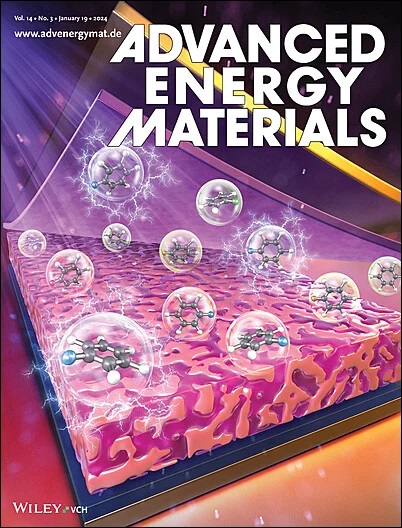Ion Redistribution Gel Electrolyte Dissipates Interfacial Turbulence for Aqueous Zinc-Ion Batteries
IF 24.4
1区 材料科学
Q1 CHEMISTRY, PHYSICAL
引用次数: 0
Abstract
Aqueous zinc-ion batteries (AZBs) degrade under a high current density due to the existence of interfacial turbulence with severe concentration polarization. Herein, an ion redistribution gel electrolyte is introduced to stabilize the electrode-electrolyte interface by regulating the ion density gradient. Negatively charged carboxymethyl groups in carboxymethyl starch ether polymer (PCMS) electrolytes can preferentially regulate the ion concentration at the anode interface. The quasi-solid PCMS gel electrolytes can dissipate the charge accumulation caused by ion concentration differences, which is beneficial for achieving excellent electrochemical stability at high current densities. As a result, the symmetric Zn cells with PCMS gel electrolyte can be cycled for more than 2000 h at a high current density of 40 mA cm−2. Furthermore, the Zn//I2 cell using PCMS gel electrolyte also sustained cycling for over 8000 cycles, and the pouch cell with PCMS gel electrolyte exhibited practical deformable applications in flexible devices. This work highlights an effective gel electrolyte approach for enhancing interfacial stability, potentially advancing the development of highly reversible AZBs.

求助全文
约1分钟内获得全文
求助全文
来源期刊

Advanced Energy Materials
CHEMISTRY, PHYSICAL-ENERGY & FUELS
CiteScore
41.90
自引率
4.00%
发文量
889
审稿时长
1.4 months
期刊介绍:
Established in 2011, Advanced Energy Materials is an international, interdisciplinary, English-language journal that focuses on materials used in energy harvesting, conversion, and storage. It is regarded as a top-quality journal alongside Advanced Materials, Advanced Functional Materials, and Small.
With a 2022 Impact Factor of 27.8, Advanced Energy Materials is considered a prime source for the best energy-related research. The journal covers a wide range of topics in energy-related research, including organic and inorganic photovoltaics, batteries and supercapacitors, fuel cells, hydrogen generation and storage, thermoelectrics, water splitting and photocatalysis, solar fuels and thermosolar power, magnetocalorics, and piezoelectronics.
The readership of Advanced Energy Materials includes materials scientists, chemists, physicists, and engineers in both academia and industry. The journal is indexed in various databases and collections, such as Advanced Technologies & Aerospace Database, FIZ Karlsruhe, INSPEC (IET), Science Citation Index Expanded, Technology Collection, and Web of Science, among others.
 求助内容:
求助内容: 应助结果提醒方式:
应助结果提醒方式:


